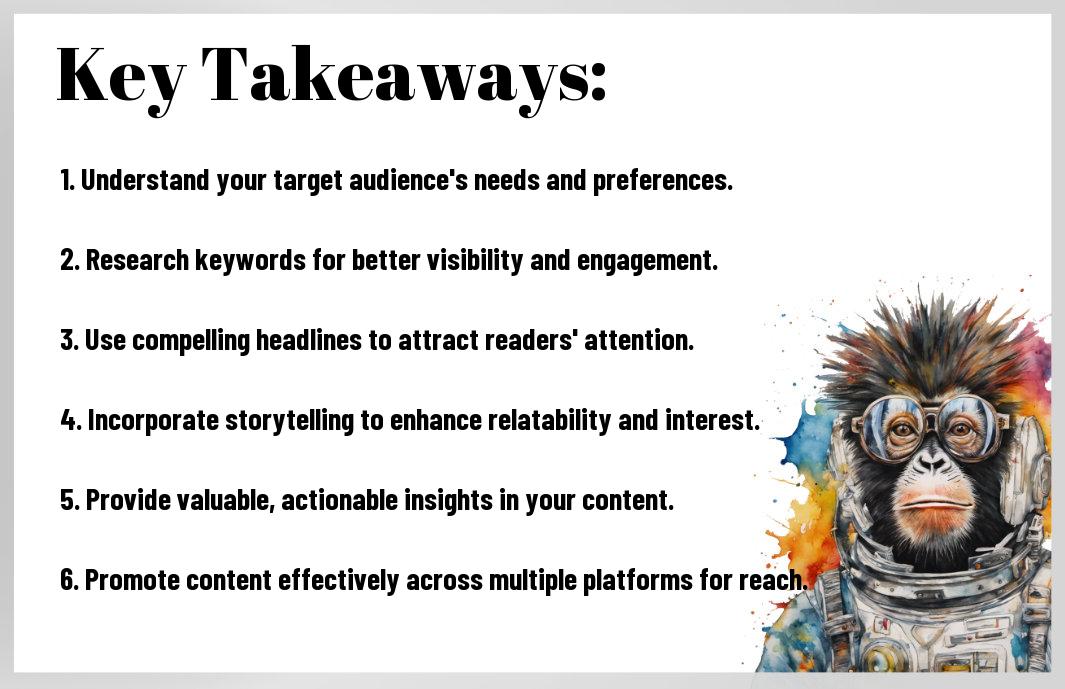It’s imperative to understand that creating quality content for affiliate marketing can significantly impact your success. I want to share the key strategies that can elevate your content and engage your audience effectively. By focusing on genuine value, proper SEO techniques, and a compelling narrative, you can drive conversions and establish trust with your readers. If you’re looking for more in-depth insights, I highly recommend checking out the Secrets To Achieving Affiliate Marketing Success. Your journey to creating outstanding content starts now!

Understanding Affiliate Marketing
For anyone interested in making money online, understanding affiliate marketing is important. This form of marketing allows individuals to earn a commission by promoting other companies’ products or services. Essentially, you partner with a business and promote their offerings through various channels—in exchange, you receive a percentage of the sales generated through your promotional efforts. This creates a win-win scenario: the company gains a new customer while you earn a profit from successful referrals.
What is Affiliate Marketing?
Below the surface, affiliate marketing operates on a straightforward principle: you review, recommend, or showcase a product and earn a commission for every sale made through your unique affiliate link. It encompasses various forms of media, including blogs, social media, email marketing, and more. Understanding the different components—advertisers, publishers, and consumers—will equip you with the knowledge needed to thrive in this field. As I investigate deeper into this subject, you will notice that the relationships you build with your audience can significantly impact your overall success.
Importance of Quality Content
Quality content plays a vital role in the success of any affiliate marketing endeavor. It serves as the foundation upon which your audience builds trust in you. The type of content you create not only needs to be informative and engaging, but it must also resonate with your target audience. By providing content that adds value, I find that I can encourage my readers to take action, such as clicking your affiliate links or making purchases. Ultimately, it is the quality of your content that can either attract or repel potential customers.
In fact, businesses today are inundated with content, making it easy for consumers to be overwhelmed or skeptical. By offering high-quality, authentic insights and recommendations, you position yourself as a credible source, thus driving more traffic to your affiliate links. Strong content enhances user experiences, increases engagement, and boosts conversion rates. A concentrated focus on cultivating quality not only builds a loyal audience but also fosters deeper relationships that can lead to long-term revenue growth.

Key Elements of Quality Content
Any successful affiliate marketing strategy hinges on the creation of quality content that not only informs but also engages and converts. This means incorporating various elements that appeal to your audience and resonate with their needs and interests. Among these elements are relevance, originality, and engagement. By mastering these components, you significantly enhance the effectiveness of your content, leading to higher conversion rates and a more loyal audience.
Relevance to the Audience
Against the backdrop of a saturated market, the importance of creating content that is relevant to your audience cannot be overstated. When you understand who your readers are and what they are seeking, you can tailor your content to answer their questions and fulfill their needs. This means using insights from market research and analytics to drive your topic choices, ensuring that what you produce resonates with the target demographic. Focus on creating material that provides real value, whether it’s solving problems, showcasing products, or sharing useful information that aligns with your audience’s interests.
Originality and Uniqueness
The landscape of affiliate marketing thrives on authenticity, making originality and uniqueness highly valued attributes in the content I create. In a world where many are regurgitating the same information, it is your distinct voice and innovative ideas that will set you apart. This requires not only a deep understanding of your subject matter but also the willingness to present it through your unique lens. I strive to ensure that my content does not mimic others, but rather offers fresh perspectives and insights that the audience can’t find anywhere else.
Further, the drive for originality does not solely come from creativity; it is also a reflection of your commitment to quality. I challenge myself to go beyond surface-level information and provide in-depth analyses, personal anecdotes, and actionable tips. When you create content that is both original and unique, it not only positions you as an authority in your niche but also builds trust with your audience, leading to greater engagement and loyalty. This emphasis on originality and uniqueness ensures your content remains relevant and valuable amidst a sea of generic offerings.
Crafting Engaging Headlines
After investing time and energy into creating your content, the next step is to ensure your audience sees it. Crafting engaging headlines is necessary for capturing attention and enticing readers to click. I often find that my headlines are the first impression I make, which is why I spend dedicated time perfecting them. A well-crafted headline should convey the essence of your content while sparking curiosity. You want readers to feel compelled to learn more, prompting them to explore your article.
The Art of Headline Writing
About 80% of people will read my headlines, but only 20% will go on to read the entire content. This stark reality highlights the importance of mastering the art of headline writing. I focus on using strong words, numbers, and intriguing questions to draw in my audience. For example, headlines like “7 Simple Strategies to Boost Your Affiliate Sales” or “How I Doubled My Revenue in 30 Days” can be incredibly effective. By integrating specifics or posing a question, I am able to evoke a sense of urgency and relevance that resonates with my potential readers.
Using Keywords Effectively
Effectively incorporating keywords into my headlines is a strategy that enhances both visibility and relevance. I make sure to identify the main keywords that my audience is searching for and weave them naturally into my headlines. This practice not only improves my content’s chances of ranking higher on search engines but also aligns it with what my audience is looking for. By focusing on relevant keywords, I ensure that my content meets the needs and interests of my target market.
And part of using keywords effectively is understanding the balance between creativity and optimization. It’s tempting to overstuff headlines with keywords to appeal to search engines, but I keep it authentic to my voice. A headline like “Discover Top 10 Affiliate Marketing Tips to Earn Extra Income” hits the sweet spot—it offers value, is easy to read, and includes relevant keywords without feeling forced. Always prioritize clarity and intrigue, and your audience will not only click but engage with your content. This balance is what will set your affiliate marketing efforts apart from the competition.
Building Trust with Your Audience
Now, as I dive deeper into affiliate marketing, I can’t stress enough how important it is to build trust with your audience. This foundation of trust dramatically impacts the effectiveness of your content and, ultimately, your conversion rates. You can craft the most compelling marketing strategies, but if your audience feels they are interacting with a faceless entity, they are unlikely to take action. Establishing a warm and genuine connection is the key to persuading your audience to engage with your recommendations.
Transparency and Authenticity
Trust is the cornerstone of any meaningful relationship, including the one between you and your audience. By being transparent about your affiliations and motives, you pave the way for a more authentic relationship with your followers. This means openly sharing when you are promoting products for which you receive a commission, as well as providing honest reviews about your experiences with those products. People appreciate transparency, and it enhances your credibility in the vast sea of online content.
Providing Value and Solutions
Behind every successful affiliate marketing strategy lies the ability to provide genuine value. Instead of focusing solely on pushing products or services, I encourage you to take a more consultative approach. Position yourself as a problem solver by understanding your audience’s needs and offering valuable solutions. When you create content that educates, assists, or solves a problem for your readers, they are more likely to trust your recommendations and take action.
Considering that many consumers are inundated with constant marketing messages, it’s crucial to stand out by delivering content that addresses their specific concerns and interests. When I focus on creating informative pieces that not only showcase products but also explain how these products can genuinely improve their lives, I’m effectively turning my content into a resource. This strategy fosters long-term relationships, as you become not just another affiliate marketer but a trusted advisor in their journeys.

SEO Best Practices for Affiliate Content
Not only does Search Engine Optimization (SEO) play a vital role in the success of your affiliate marketing content, but adhering to best practices can significantly enhance your visibility and drive more traffic. It’s necessary to ensure that your content is not just valuable and engaging, but also optimized for search engines. SEO involves a blend of strategies that elevate your content in search rankings, making it easier for potential customers to find your affiliate links. By implementing these strategies effectively, you can maximize the potential of your content and improve your earnings.
On-Page Optimization Strategies
Against common misconceptions, on-page optimization is not merely about stuffing keywords into your content. It requires a balanced approach that enhances the user experience while making your page more appealing to search engines. You should focus on creating compelling, relevant titles, using meta descriptions that accurately summarize your content, and strategically incorporating targeted keywords into your headings and text. Additionally, using alt text for images and ensuring your content is easy to read can further optimize your page, giving both users and search engines a clear understanding of your content.
Off-Page Techniques and Link Building
About improving your online presence, off-page techniques and link building are equally necessary components of a successful SEO strategy. These methods focus on building your site’s authority by acquiring backlinks from reputable sources. When you establish relationships with other bloggers or websites in your niche and earn their trust, they are more likely to link back to your content. This not only drives traffic to your site but also signals to search engines that your content is valuable and trustworthy, which can improve your rankings.
For instance, guest blogging on related sites, engaging in forums, and collaborating with influencers can be effective strategies for building those all-important backlinks. By sharing your expertise and providing value to others, you not only promote your affiliate content but also enhance your site’s credibility. This relationship-building process can lead to natural link-building opportunities, boosting your visibility and positioning in search results—so focus on quality over quantity when it comes to acquiring links. The right strategies will help solidify your reputation and pave the way for ongoing success in affiliate marketing.
Leveraging Multimedia for Enhanced Engagement
All forms of multimedia have the potential to significantly elevate your affiliate marketing content. By incorporating elements like images and videos, you can create a more dynamic and engaging experience for your audience. High-quality visuals not only draw the reader’s attention but also communicate your message effectively. I’ve found that when I combine compelling visuals with my written content, I can maintain the reader’s interest and improve their overall understanding of the products I’m promoting. Videos, particularly, have the added benefit of demonstrating product use, adding a layer of authenticity that static images often cannot convey. They let your audience see and hear the product in action, which can result in increased trust and a higher likelihood of conversions.
The Role of Images and Videos
Above all, using images and videos strategically can lead to a more interactive experience. I make it a priority to choose visuals that not only complement the text but also evoke emotions that resonate with my target audience. For instance, if I’m promoting fitness products, using vibrant action shots or customizable video tutorials can inspire potential buyers more effectively than text descriptions alone. The key is to ensure that your images and videos are not just eye-catching but also relevant to your content. A clear connection between your multimedia elements and your messaging will help keep your readers engaged and more likely to respond positively to your affiliate referrals.
Infographics and Visual Content
For any content creator, infographics serve as a powerful way to summarize important information in a visually appealing format. I’ve noticed that infographics can distill complex data into simplified visuals that are easy to digest, making them incredibly valuable for affiliate marketing, particularly when presenting comparisons, statistics, or step-by-step guides. When I include infographics in my content, I see higher shares and increased interaction from my audience, which, in turn, drives more traffic to my affiliate links.
Engagement is a key factor that drives the success of your affiliate marketing efforts. When piecing together visual content like infographics, it’s important to keep them informative yet visually appealing. Utilize compelling layouts and color schemes that align with your brand to foster a connection with your audience. However, be cautious about overcrowding your infographics with information; a cluttered design can overwhelm your viewers, leading to decreased interest. Instead, focus on a clean aesthetic that highlights only the most important details, guiding your readers while facilitating an enjoyable reading experience. By prioritizing this balance, you’ll create visuals that not only captivate but also educate your audience.
Conclusion
Following this journey into the secrets of creating quality content for affiliate marketing, I’ve come to understand that authentic engagement and strategic planning are paramount. It’s not just about churning out content; it’s about crafting valuable pieces that resonate with your audience. By focusing on their needs and preferences, you can deliver solutions that genuinely help them while subtly guiding them towards the products you’re promoting. When you place your audience at the center of your content strategy, you build trust and authority, both vital for successful affiliate marketing.
Moreover, integrating SEO best practices will allow your content to reach a wider audience, ensuring that your insights and recommendations do not go unnoticed. The balance between creating informative, engaging content while optimizing it for search engines can significantly enhance your visibility. So, as you initiate on your content creation journey, keep in mind the importance of quality, consistency, and a clear call to action. With these elements in place, you will see a transformative impact on your affiliate marketing efforts.
Q: What are effective strategies for identifying quality content topics in affiliate marketing?
A: To identify quality content topics, start by researching your target audience’s interests and pain points. Utilize tools like Google Trends, keyword research tools, and social media platforms to see what topics are currently being discussed. Engaging with online communities, such as forums or social media groups related to your niche, can also provide insight into what your audience is looking for. Moreover, reviewing competitors’ content can help pinpoint gaps that you can address with your unique perspective or additional information.
Q: How can I enhance the readability and engagement of my affiliate marketing content?
A: Enhancing readability and engagement involves using a clear structure and formatting. Break your content into sections with headings and subheadings to improve scannability. Use bullet points or numbered lists for easy digestion of information. Incorporating visuals like images, infographics, and videos can also aid in maintaining reader interest. Additionally, writing in a conversational tone and addressing your audience directly fosters a stronger connection, making them more likely to engage with your content and take action.
Q: What role does SEO play in creating quality content for affiliate marketing?
A: SEO plays a significant role in ensuring that your content is discoverable by search engines, which can lead to increased traffic and potential conversions. Start by conducting thorough keyword research to identify relevant terms that your audience searches for. Integrate these keywords naturally throughout your content, including in headers, meta descriptions, and image alt texts. Additionally, focus on creating high-quality backlinks and optimizing page load speeds to improve your content’s ranking. Keeping up with SEO best practices enables your affiliate content to reach a wider audience effectively.



